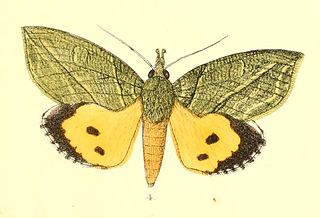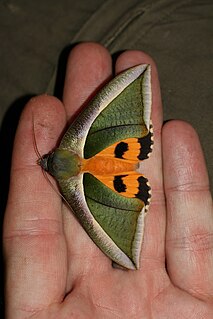
Deudorix epijarbas, the cornelian or hairy line blue, is a species of lycaenid or blue butterfly found in south and southeast Asia from India to Fiji, including the Philippines, and also the tropical coast of Queensland in Australia. The species was first described by Frederic Moore in 1857.

Corcobara is a monotypic moth genus of the family Erebidae first described by Frederic Moore in 1882. Its only species, Corcobara angulipennis, described by the same author in the same year, is found in India, Thailand, Cambodia, Myanmar, Malaysia, Indonesia, New Guinea, Sri Lanka and the Solomons.

Hulodes caranea is a species of moth of the family Erebidae first described by Pieter Cramer in 1780. It is found from India, Sri Lanka, Myanmar, Java, Hong Kong to Queensland and New Guinea, it is also found on the Marianas and Carolines.

Eudocima homaena is a moth of the family Erebidae first described by Jacob Hübner in 1816. It is found in the Indian subregion, Sri Lanka, Taiwan, the Nicobars, Peninsular Malaysia, Borneo, the Philippines and on Christmas Island. It is a major pest on orange plants.

Eudocima hypermnestra is a moth of the family Erebidae described by Pieter Cramer in 1780. It is found in China, Thailand, Taiwan, India and Sri Lanka.

Eudocima salaminia, the green fruit-piercing moth, is a moth of the family Erebidae. The species was first described by Pieter Cramer in 1777. It is found from India, and across south-east Asia to the Pacific Islands. In Australia it occurs in the Northern Territory, Queensland and New South Wales. The adult is a fruit piercer.

Asota caricae, the tropical tiger moth, is a species of noctuoid moth in the family Erebidae. It is found from the Indo-Australian tropics of India and Sri Lanka to Queensland and Vanuatu.

Eucyclodes gavissima, the Oriental orange banded green geometer moth, is a species of moth of the family Geometridae described by Francis Walker in 1861. It is found in the Indian subregion, Sri Lanka, Bhutan, western China, Taiwan, Sumatra and Borneo.

Nycteola revayana, the oak nycteoline, is a moth of the family Nolidae. The species was first described by Giovanni Antonio Scopoli in 1772. It is found from Europe and east across the Palearctic to Japan and India.

Ramadasa pavo is a moth of the family Noctuidae first described by Francis Walker in 1856. It is found in south-east Asia. including Sumatra, Borneo, Sabah, Sulawesi, Thailand, Sri Lanka, India and China.

Eutelia geyeri is a moth of the family Noctuidae first described by Rudolf Felder and Alois Friedrich Rogenhofer in 1874. This species is found in India, Sri Lanka, China and Japan, as well as from Africa, where its presence had been reported from Lesotho and Seychelles.

Autoba abrupta is a species of moth of the family Erebidae. It is found in Papua New Guinea, Thailand, and Australia. The species is largely used by the name Eublemma abrupta in Indian and Sri Lankan texts.
Calamotropha atkinsoni is a moth in the family Crambidae. It was described by Philipp Christoph Zeller in 1863. It is found in south-east Asia, where it has been recorded from India, Sri Lanka, Thailand, Singapore and Sulawesi.
Roxita adspersella is a moth in the family Crambidae. It was described by Pieter Cornelius Tobias Snellen in 1893. It is found in Sri Lanka.
Ptychopseustis argentisparsalis is a moth in the family Crambidae. It is found in Sri Lanka.
Patissa lactealis is a moth in the family Crambidae. It was described by Cajetan Felder, Rudolf Felder and Alois Friedrich Rogenhofer in 1875. It is found in Sri Lanka.
Syllepte cometa is a moth in the family Crambidae. It was described by William Warren in 1896. It is found in Assam, India.
Nordstromia humerata is a moth in the family Drepanidae. It was described by Warren in 1896. It is found in north-eastern India.
Microblepsis cupreogrisea is a moth in the family Drepanidae. It was described by George Hampson in 1895. It is found in Myanmar, the north-eastern Himalayas and on Borneo and Sumatra.
Streptoperas luteata is a moth in the family Drepanidae. It was described by George Hampson in 1895. It is found in the north-eastern Himalayas and on Borneo, Sumatra, Java, Bali and Sulawesi.











